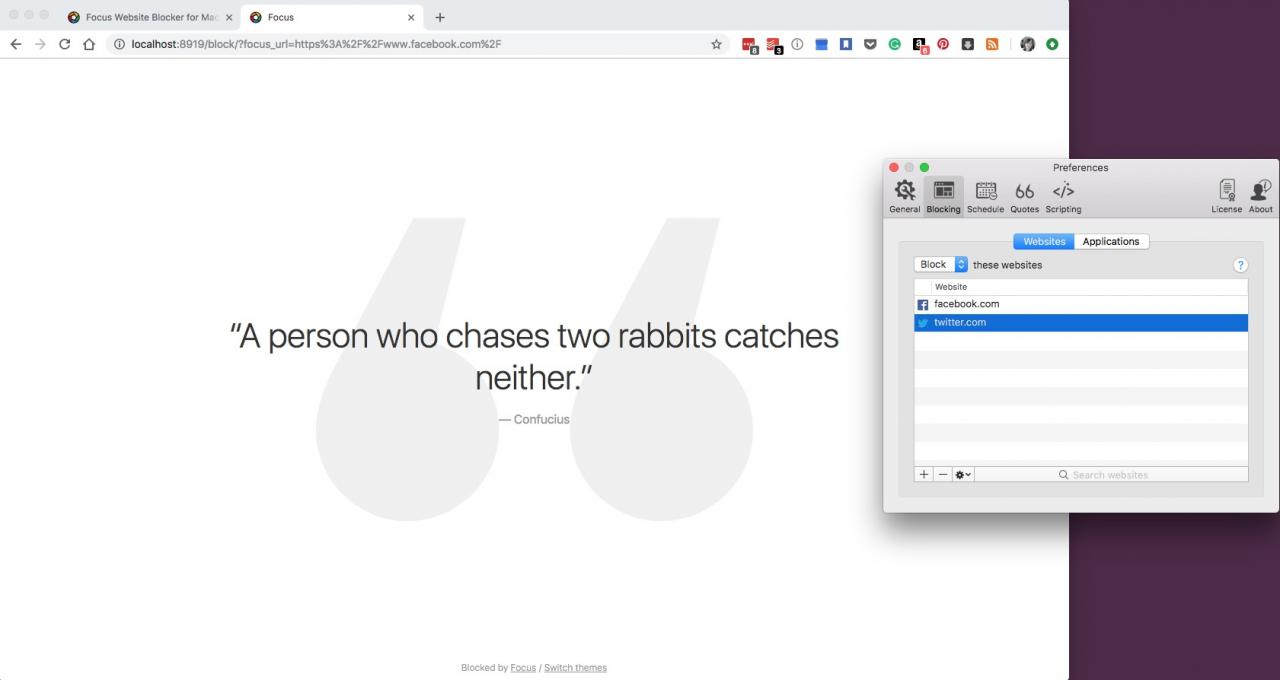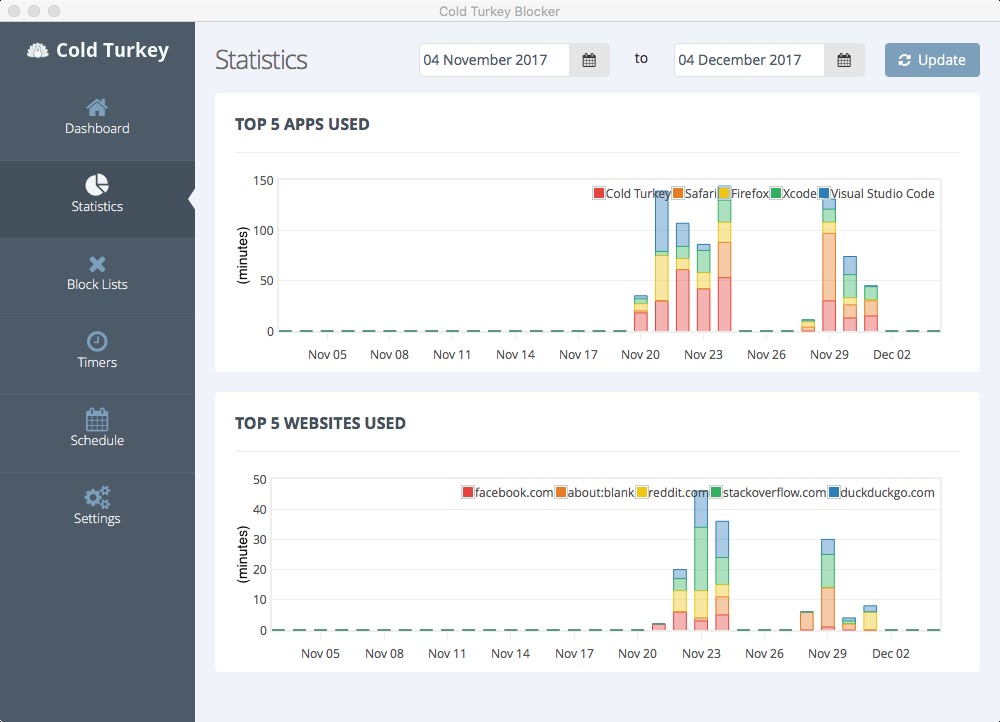Social networks, e-mails and countless other distractions vie for our attention in our everyday lives. It is often difficult to concentrate fully on a single task. Fortunately, there are many apps that can help us focus, organize our tasks, and get the most out of our time.
Apps for blocking social networks, websites and emails
Do you know that? You pick up your smartphone or open your browser and click on Facebook, Instagram or Twitter for the hundredth time that day. The clever inventors of these social networks deliberately designed their apps to be addicting. And sometimes it is useful to have the help that keeps this addiction in check.
Focus is an app for the Mac that I use myself and that helps you limit your use of social media. It can also ensure that you don’t keep checking your e-mails or visiting your favorite website. You can select certain pages to be blocked and then concentrate on a task either over the standard period of 25 minutes or a specially set period. Alternatively, it is possible to set a daily period within which apps, websites and emails are blocked. For example, you could block them from 9:30 a.m. to 12:30 p.m. and allow yourself to watch social media, etc. during your lunch break. Trying to access a blocked website, e.g. B. Facebook, you get a motivational slogan instead. The focus has an integrated Pomodoro timer. The Pomodoro method is a time management method in which you divide your task into specific work intervals with a short break in between. After several periods of work there is then a longer break.

Cold Turkey has very similar functions to Focus, but with the advantage that it is suitable for both PC and Mac. An interesting additional function is that you can lock the timer to prevent changes. This means that it is much more difficult to bypass the timer. This can be useful when you are easily distracted. Before deciding to block certain apps or websites, you can use your computer as usual as a test and only use the app’s statistics mode to see how much time you spend on which pages.

Most of us are not only distracted at the computer but also have smartphones and tablets. This is where the Freedom app intervenes. In addition to versions for PC and Mac, there is also an iOS version. Freedom can be used to block websites, emails and apps to restrict usage. If there is a need to be completely focused on one thing, the internet can be blocked completely. There is also a lock mode that you can use when you are not motivated. This ensures that you don’t just look into social networks and get distracted from work. An interesting feature of Freedom is that its availability for Mac, PC and iOS makes it possible to synchronize the blocking of distractions on different devices. This means that you won’t be tempted to take a quick look at your iPhone while you’re working on your computer. Freedom can also be used to schedule blocking and recurring blocks in advance. This means that an entire working week can be planned without distractions.
If you use Android, you should take a look at the AntiSocial app. Download the app and use it for two weeks. The app controls how often you use your smartphone and what you do with it compared to other users worldwide. This gives you information about which apps you spend most of your time with. Then you can blacklist certain apps to restrict their use.
“Do not disturb” mode and turning off app notifications
A simpler option than downloading an app is to put the smartphone in “do not disturb” mode. Then you no longer receive app notifications and calls when you really have to concentrate. It would be even better to turn off notifications from sites like Facebook and Instagram. This avoids having to go to these pages immediately and respond to comments or new posts.
Apps for writing without distractions
If you have to write texts for a blog or offers, a writing app with numerous functions can easily distract you. It is often best to just write down all of the information quickly, without worrying too much about the format. As soon as this first draft is ready, it’s time to format and edit. There are numerous options for writing without distractions. Here is a small selection:
I use this app myself, especially when I want to quickly create a draft idea. The user interface is deliberately kept very simple and white. All you have to do is start typing. There is also the option to put the app in paragraph or sentence mode. For example, if you choose sentence mode, any previous sentence will be hidden while you write the next. This does not tempt you to revise what has been written before you have created a complete first draft. This is how you create texts faster. If a certain number of words or character restrictions have to be adhered to, this can be indicated in the upper right corner. To be even less distracted, the app can be used in full-screen mode. Mood music or a raindrop noise can also be played optionally, although I personally find this a bit annoying. When you’re ready to format your text, you can do so with Markdown, or use the formatting menu at the top of the screen. The text can be saved in a variety of formats including rich text, PDF, and HTML, which is very useful for blog post writing.
IA Writer is another distraction-free writing tool. It has a similar structure to Focused but is also available for PC, Android and iOS. As with Focused, the user interface is simple and clear and allows you to concentrate on only one sentence or paragraph at a time.
To-do apps for the organization
Todoist is currently my app for organizing my freelance design work and personal projects. It is easy to use and yet has many useful features. The easiest way to get started is by adding a project; B. “My Brochure Design Project”. You can then create tasks/to-do items within this project. For example, you could do one task called “Briefing” and another called “First Imagery”. A deadline can be specified for each task and reminders can be sent for it. If you want to go further, you can also add a label to the tasks, e.g. B. the customer name. Todoist then shows what you have to do “Today” or within the next 7 days.
As soon as you have completed a task, you simply click into the task area and it disappears. Another useful function of the app is the ability to plan recurring tasks. For example, if you need to design a regular newsletter for a customer, you could schedule this task on a monthly basis. You can also use Todoist to assign tasks to other people you’re working with on a project. So if you were working with a colleague, you could assign certain tasks to that person and do the rest yourself. Another great time-saver is that you can turn emails from Outlook or Gmail into tasks. Suppose a customer sends you a message with attachments. Then you can easily turn those emails into a task on your list.

Do you remember an app called Wunderlist? It was an incredibly popular and easy-to-use to-do app for organizing tasks at work and in everyday life. It was bought by Microsoft and the new version of it is called Microsoft To-Do. If you use Windows this app could be a good choice for you as it can be tuned to work with Outlook. Microsoft To-Do works similarly to most to-do apps. You can create lists and divide them into different tasks with deadlines and reminders. In addition, tasks can be repeated and broken down into sub-tasks called “steps”. As soon as you have created a list and tasks, you can either view them under “My Day”, where the tasks for the respective day are displayed or in “Planned” where they can be viewed under the headings “Today”, “Tomorrow” and “The next 5 days” are inserted.
Similar apps like Todoist and Microsoft To-Do
The apps Things (Mac and iOS) and OmniFocus (Mac and iOS) have a similar structure to Microsoft To-Do and Todoist. Before I switched to Todoist, I was using Things. This app has a nice user interface, but my problem with both applications is that they have separate licenses for the Mac and iOS platforms, making them a bit more expensive.
Trello works differently than the apps mentioned above. You start by making aboard. This board stands for a specific project, for example. Lists can then be created within the board. There are different cards on the lists. There are many different ways you can use lists. For example, you can have a list for every type of job in a project, e.g. B. Design, Social Media and Meetings. In these lists, cards are created for the respective tasks. These cards can then be used to add text, images and links, as well as a due date. You can also add other people in Trello, which is useful for community projects.

If you already use Google products like Gmail and Google Calendar, you might find it worth checking out Google’s free and easy-to-use to-do app, Tasks, which works with both applications can vote. With this app lists can be created and tasks with due dates can be added. Sub-tasks can also be created.
Simply planning a day or a week can help you be more productive. It’s also a very satisfying feeling to check off things on the to-do list. The additional planning of smaller tasks that have nothing to do with work leaves your head free to concentrate on the current task.

